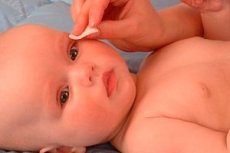Medical expert of the article
New publications
Baby eye wash
Last reviewed: 04.07.2025

All iLive content is medically reviewed or fact checked to ensure as much factual accuracy as possible.
We have strict sourcing guidelines and only link to reputable media sites, academic research institutions and, whenever possible, medically peer reviewed studies. Note that the numbers in parentheses ([1], [2], etc.) are clickable links to these studies.
If you feel that any of our content is inaccurate, out-of-date, or otherwise questionable, please select it and press Ctrl + Enter.

Children are most susceptible to eye trauma and irritation. The washing procedure is the simplest and at the same time the most effective method to eliminate the problem. Irrigation of the conjunctival sac is carried out in case of inflammatory diseases, increased lacrimation, purulent discharge and other painful conditions.
Particular attention should be paid to the choice of solution for eye treatment. The safest and most effective eye wash liquids are:
- Furacilin - take 1 tablet of the drug and pour 100 ml of boiled water. As soon as the tablet is completely dissolved, the product can be used to wipe the affected eye, after straining the solution through several layers of gauze.
- Potassium permanganate (manganese) – to prepare a washing solution, take a small amount of potassium permanganate and dilute it in boiled water at room temperature (recommended proportion 1:5000). The finished liquid should be pale pink. To treat the eyes, soak a cotton pad in the solution and place it on the child’s eyes.
- Saline solution (sodium chloride) - this medicine can be prepared independently or purchased ready-made solution at the pharmacy. Take a teaspoon of salt and dissolve it in a glass of warm water. The remedy is effective for conjunctivitis of bacterial and viral origin and as a liquid for washing out foreign particles from the eyes.
There are also folk recipes based on medicinal herbs for treating the organs of vision:
- Chamomile - decoctions and infusions are prepared from it. Take a spoon of dry raw material and pour a glass of boiling water. After cooling, strain and use for instillations or eye baths. Chamomile relieves inflammation, reduces swelling of the eyelids and redness, fights pathogenic microorganisms.
- Calendula – pour 10 g of plant flowers with 500 ml of boiling water and simmer over low heat. After cooling, filter. The decoction can be used for compresses or washing. The product has pronounced anti-inflammatory properties.
- Tea – to prepare a medicinal solution, you can use both black and green leaf tea without flavors or additives. Pour a glass of boiling water over a spoonful of large-leaf raw material and let it brew until it cools. The drink is suitable for compresses and irrigations.
In order for the treatment to be effective, it is necessary to adhere to certain rules when preparing solutions for rinsing. First of all, only boiled or filtered water can be used. The prepared liquids should be at a comfortable temperature, too hot or cold can increase irritation of the cornea and painful sensations.
In case of inflammatory lesions, treatment should be carried out for both eyes, even if only one is ill. It should also be taken into account that if the eye lesion is caused by an infectious or bacterial lesion, then only rinsing will not help. The child should be shown to a pediatrician and an ophthalmologist, who will draw up an appropriate treatment plan.
Eye Wash in Newborns
A mandatory procedure that young parents face is washing the eyes of newborns. Eye treatment is part of daily hygiene, as well as a method of preventing inflammatory and infectious processes.
Some babies have a problem with purulent discharge accumulating in the corners of the eyes. Suppuration is most often associated with the following factors:
- Conjunctivitis (bacterial, viral, infectious).
- Dacryocystitis is a congenital inflammation of the mucous ducts due to their obstruction.
- Allergic reactions due to exposure to external irritants (detergents, dust, animal hair).
The above conditions are accompanied by profuse lacrimation, photophobia, itchy eyes and increased anxiety in the child.
The procedure should be carried out in compliance with certain rules:
- The mother should wash her hands thoroughly and prepare sterile gauze pads, wipes and a solution for rinsing in advance.
- For the comfort of the newborn, it is necessary to swaddle him well. At the same time, the child should not sleep, since the touch of a wet compress can frighten him.
- Rinsing is carried out from the outer corner of the eyes to the bridge of the nose.
- A separate compress and napkin are used for each eye. Excess liquid is carefully blotted with a soft napkin.
- When instilling the medicine, you need to gently pull down the lower eyelid and instill 1-2 drops closer to the corner of the eye. Then close the eye and massage from the temple to the nose.
When choosing a liquid for installations, you should consult a pediatrician. For eye care, you can use warm boiled water, saline solution, herbal decoctions. The procedure is performed by wiping the closed eyelids with a sterile cotton pad, abundantly moistened in the solution.
If there are inflammatory reactions, it is contraindicated to use breast milk, hydrogen peroxide, any alcohol solutions and physiological fluids (urine, saliva), hormonal or vasoconstrictor drugs. It is also prohibited to use wet wipes that are used to care for the skin of a newborn.

